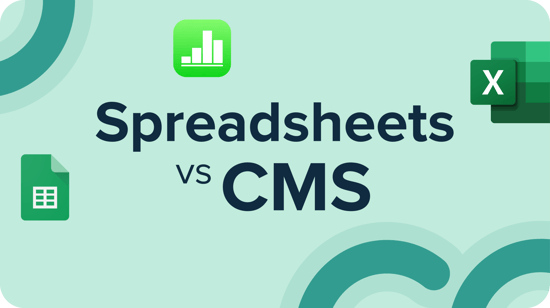The difference between spreadsheets & specialised contract management software
While Excel and spreadsheets have long been versatile tools for various tasks, they fall short when it comes to managing contracts efficiently. Manual management in spreadsheets is cumbersome and requires a significant investment of time and effort. This contract management method is considered as too risky and is therefore advised against. In this blogpost, we will explain why exactly.

- Manual Processes and Formula Dependency
One of the significant drawbacks of using spreadsheets for contract management is its reliance on manual inputs and formula knowledge. Automating prompts in Excel or other spreadsheets demands a level of expertise that not every colleague possesses. This knowledge gap creates a dependency on a limited number of individuals, and when key stakeholders leave the company, the continuity of contract management becomes a significant concern. Furthermore, the risk of errors is inherent in spreadsheets,, making it easy for unintended changes to occur, or worse, an entire worksheet to be deleted inadvertently.
- Access Rights Challenges
Access rights are another substantial issue when managing contracts in spreadsheets like Excel, Numbers or online sheets. Determining who has access to sensitive contract information can be a complex and error-prone task. Excel and Numbers lack the capability to enforce robust access controls, leaving organizations vulnerable to data breaches and unauthorized modifications that could compromise the integrity of contractual agreements.
- Static Nature and Lack of Adaptability
Spreadsheets are oblivious to the dynamic nature of contracts. They fail to comprehend the complexities introduced by changing legislation, addenda, or general conditions. Contract terms can evolve over time, and a spreadsheet’s static nature makes it challenging to adapt to these changes seamlessly. This deficiency in agility can lead to non-compliance and missed opportunities for optimizing contractual relationships.
- Collaboration Challenges with Diverse Software
Collaboration can be hindered by the diversity of spreadsheet software used by stakeholders. While some may prefer Numbers or different versions of Excel, others may opt for Google Sheets. This lack of uniformity not only poses compatibility issues but also limits the accessibility of crucial contract information. In an era where seamless collaboration is imperative, the constraints of spreadsheets become increasingly apparent.
- Restricted usability in the entire contract lifecycle
While spreadsheets can be utilized for tracking contract dates, their functionality is too restricted to facilitate every step of the contract management process. Unlike dedicated contract management software, spreadsheets lack the comprehensive features needed for efficient contract creation, negotiation, renewal, and analysis. This limitation underscores the necessity of a more robust solution to address the multifaceted aspects of contract management in a dynamic business environment.
In conclusion, while spreadsheets have served as a versatile solution for various tasks, switching to a different solution is strongly recommended. With its centralized repository, robust access controls, and dynamic tracking of changes, contract management software emerges as the ideal solution as it addresses the shortcomings of Excel. It ensures greater transparency, reduces errors, and enhances collaboration, ultimately supporting the entire contract lifecycle, instead of just part of it.
Would you like more information on how to optimize your contract management?
Fill in your details to read the complete expert paper on building the right Legal Tech Stack




